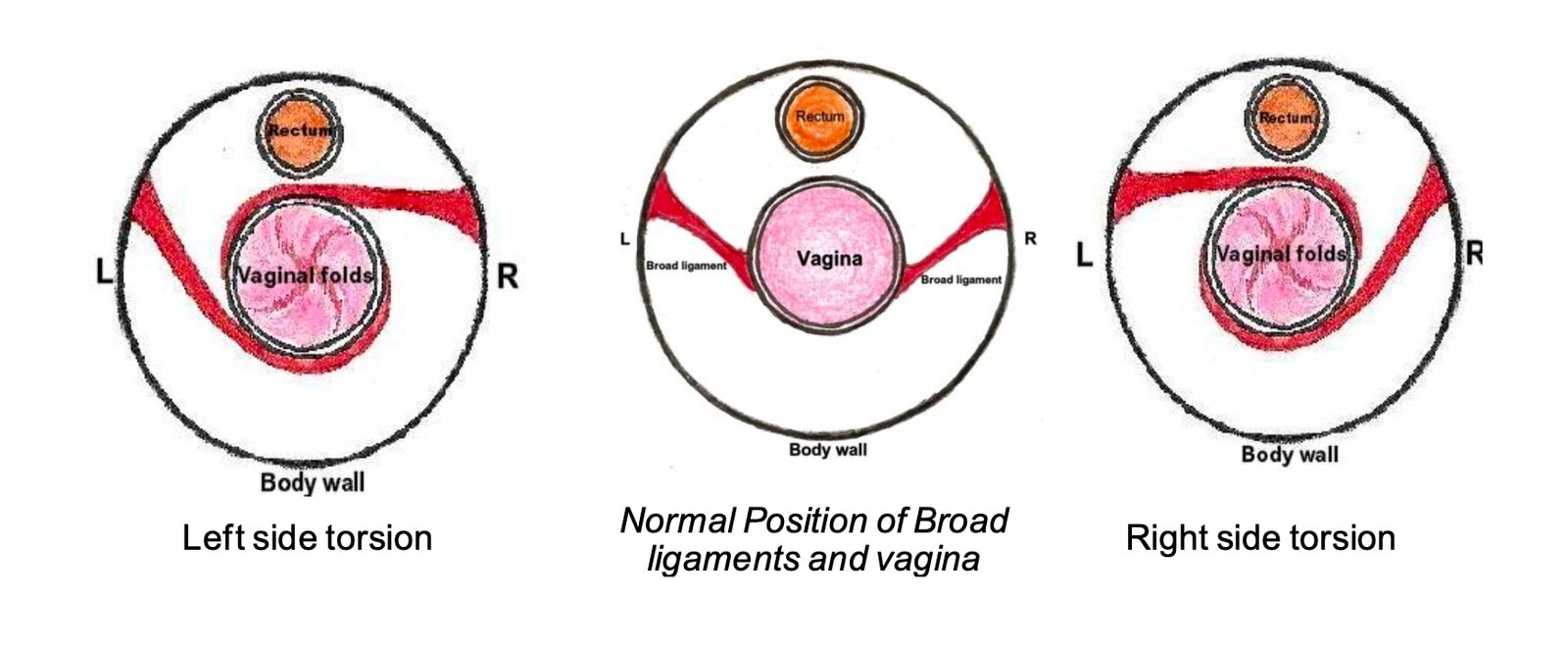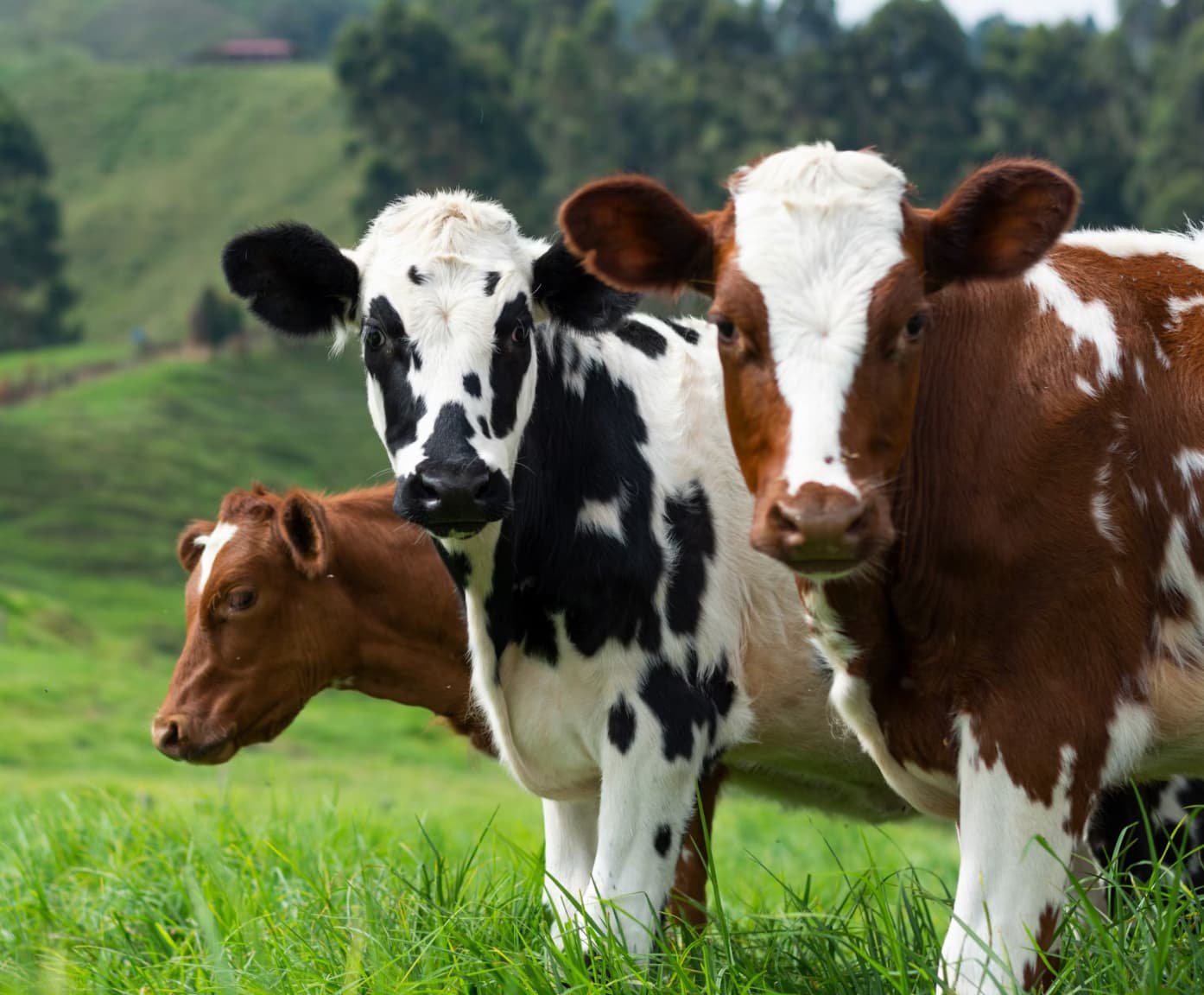TABLE OF CONTENTS
Torsion of the Uterus
Torsion of the uterus, also known as uterine torsion, torsio uteri, or uterine volvulus, is a condition in which the uterus twists around its axis.
Torsion of the uterus is defined as the twisting or revolution of the gravid uterus on its long axis and is common in cows and buffaloes, limited in ewe and goats but rare in mare, bitch and sow with the high incidence among pluriparous than primiparous.
Etiology
The possible causes for torsion of uterus in cows are as many as the complication commences in the late first state or early second stage of labour.
The lesser curvature of the uterus in advanced pregnancy is supported dorsolaterally by broad ligament.
The greater curvature lies free in the abdominal cavity resting on the abdominal floor and supported by the rumen, viscera and abdominal walls.
The ovarian end of gravid horn is relatively small and forms a base in which the uterus rests. As the non-gravid horn is small or non functional, the instability of uterus is increased. This anatomical arrangement with the manner in which the animal lies down with the fore quarters going first and rises by elevating the rear quarters suspends the gravid uterus in abdominal cavity with a slip.
Predisposing Factors
- Frequent lying down and getting up may predispose to uterine torsion.
- Lack of fetal fluids and violent falling or rolling and sudden movements may predispose to torsion.
- Close confinement of pregnant animals for a longer period may favour occurrence of uterine torsion.
- A lack of tone of the pregnant uterus comprising lack of fluids, flaccid uterine walls, a small non gravid horn, a long flaccid mesometrium favours uterine torsion.
- A deep capacious abdomen predisposes to uterine torsion and especially in buffaloes because of the wallowing habit.
- Existing causes such as horn thrust or butting by the neighbouring animal, violent movements during grazing, rolling due to tympany and colic may cause torsion.
- Transportation of pregnant animals from one place to another in rail or by road violent and irregular movements creating anxiety and predispose to torsion or uterus.
Degree and Direction of Torsion
Torsion may occur on the right side (clockwise) or left side (anti clockwise / counter clockwise). High incidence of right side torsion could be due to the presence of rumen on the left side.
Torsion involves uterus, body cervix, vagina and vulva and may be complete or incomplete and graded into four degrees depending on the degree of rotation of uterus.
Degrees of uterine torsion may range from 45° to 360° or more.
The site of the twist occurs in front of pelvic brim, if it is present at the posterior end of external os it is called as post-cervical and if it occurs in body of uterus in front of external os it is called as pre-cervical. Post cervical torsion is more common than pre-cervical torsion because of least resistance.
Clinical Signs
If the torsion is of a mild degree, 45° to 90° symptoms may be lacking upto parturition but when the severity is 180 or more signs of abdominal pain, anorexia, constipation, lack of ruminations, restlessness or colic symptoms, treading and tail switching related to the volvulus, intussusceptions, indigestions and peritonitis may be observed.
When any pregnant animal shows such signs or ailment, rectal examination is a must to rule out crossing over of broad ligament either left broad ligament in right side torsion or right broad ligament on the left side torsion.
High respiration rate, tachycardia, anorexia and animal may adopt a rocking horse stance, so that dorsal surface of the spine is concave and the forelimbs and hind limbs are held respectively forward and backward than normal foetid diarrhoea may noticed in late pregnancy and severe cases.
The amount of tension on the broad ligaments and arteries will indicate the severity of the torsion leading to restricted blood supply to uterus, fetus may die and develop emphysema, maceration or mummified fetus.
Diagnosis
Vaginal examination will reveal the side of uterine torsion and site of the torsion whether it is pre-cervical or post cervical uterine torsion.
In post cervical uterine torsion the cervix is not reachable because of the twist involving the vagina; the same may be confirmed by per rectum with the spiral folds of the vaginal tissue involving the gravid uterus.

In pre-cervical uterine torsion the cervix is reachable without any twist or fold in the vaginal passage but the torsion or twist would have occurred preceding the cervix, hence rectal examination and confirmation has to done by feeling the crossing over of the broad ligament to detect the side of torsion in order to relieve the uterine torsion.
The stretching of the broad ligament indicates degree of uterine torsion.
Prognosis
- The prognosis depends on the severity of the uterine torsion.
- Degree of uterine torsion.
- Symptoms and length of time it has existed / until diagnosed.
In mild cases of less than 90° the prognosis is good. If the severity is 180° to 270° and delayed, neglected cases prognosis is poor.
Treatment
The techniques of laparotomy, caesarean and rolling are indicated when the birth canal is so twisted that the hand cannot be passed through it to grasp the fetus.
1. Rotation of the dam
One of the oldest and simplest methods used to relieve torsion of the uterus which requires 3 to 6 men.
The cow having torsion is laid down in lateral recumbency on the same side as the direction of the torsion.
Occasionally this procedure of casting or dropping the cow suddenly on the same side relieves or partially relieves the condition. The front and hind limbs are secured separately.
The object or rolling is to suddenly and rapidly rotate the cow’s body in the same direction as that of twist.
The uterus remains stationary during rolling. After rolling the animal at 180° it is advisable to keep the hand in the vaginal passage to find out if the rolling is effective or not, after relieving which can also be judged by the relaxation or tightening of the vaginal mucous folds. On successful termination of rolling fetal fluids gush out of uterus.
2. Schaffer’s Method of Rolling the Dam
A modification of this rolling technique which has a great value involves a wooden plank of 9 to 12 feet long and 8-12 inches wide where in it is placed on the cow’s abdomen with the lower end of the plank on the ground similarly as done in the previous method a assistant has to stand on the plank and the cow is slowly rolled in the same direction as the torsion by pulling on the ropes around the front and hind feet.
This creates pressure first on the upper abdominal wall, the floor and finally the opposite side of the abdomen resulting in a correction of the torsion that can be determined by examining the genital tract.
In Schaffer’s method the uterus and its contents are held in place by the plank and the weight of the man standing on it while the cow is rotated around them.
3. Rotation of Fetus
Vaginal taxis or detorsion of fetus per vaginum is carried out when the cervix is relaxed / dilated and when the fetus can be grasped and rotated by hands. The hind quarters must be kept raised and controlled by epidural anaesthesia and passage lubricated.
The fetal limbs or head is grasped and jerked swiftly in the opposite direction carefully without rupturing water bag. The same procedure can also be carried out with the help of obstetrical instruments like “Cammerer’s de-torsion fork” in which the canvas cuffs are tied to the fore limbs of the fetus and the prongs of the fork are inserted in the cuffs as high as possible. The de torsion is effected by rotating the cross bar in the desired direction.
4. Laparotomy or Surgical Correction
Intra abdominal correction is carried out when the cervix is closed and performed on the standing posture under paravertebral nerve block.
This requires less assistance but 6–8” inches of incision has to be made on the one side of the upper flank for correcting the uterus with the operators hand. However, presence of adhesions, weight of uterus and its smooth slippery surfaces and limited space may interfere the technique.
5. Caesarean Section or Laparohysterectomy
Caesarean section or laparohysterectomy is indicated when cervix is not dilated but with a live fetus is desired or when uterine rupture has occurred with emphysematous fetus or suspected in multiparous animals such as dog, cat and sow.
Discuss about the prognosis of the animal before doing caesarean section because after correction of uterine torsion and induction of parturition the cervix may not dilate due to atony or respond to any treatment on with dead, dry and emphysematous fetus.
Under this circumstance caesarean section may be preferred with any one of the ventral abdominal laparotomy sites. Care should be taken to avoid internal bleeding, rupture of uterus and to get rid of post parturient complications like septic metritis, perimetritis, retained placenta etc.
6. Abdominal Ballottement Method
Abdominal ballottement method helps in correction of torsion through birth canal as mentioned in Rotation of fetus.
- In left torsion: An assistant on the left side pushes the upper left flank downward and inward whereas the other assistant on the right side pushes the lower flank region upward and inward.
- In right torsion: Upper right flank-push downward and inward; lower left flank: push upward and inward.
Both the assistants should push alternatively at regular intervals in quick succession which causes the uterus to roll from side to side and this helps the operator working via birth canal.
Uterine Torsion in Mare (Horse)
In general a pregnant mare rolling during colic predisposes to torsion and should be examined for torsion of uterus. Diagnosis by rectal / vaginal examination should be done to differentiate colonic obstruction.
The incidence is very less compared to cows & buffaloes because of dorsal attachments of broad ligaments and attachments of non-gravid cornua. Handling and treatment is similar to that of cows but the prognosis is usually serious.
Uterine torsion in ewe, goat, dogs and cats can be diagnosed based on the clinical signs, vaginal examination, ultrasonography and x-ray. Laparo-hysterotomy and hysterectomy is indicated to save the dam and fetus.
In ewes the peculiar sign of stiff and stilted gait called “saw horse” appearance may be noticed on examination. Correction can also be done by rolling the dam with a pad on the body for firm adherence. Caesarean is also preferred when there is no further progress is kidding.

